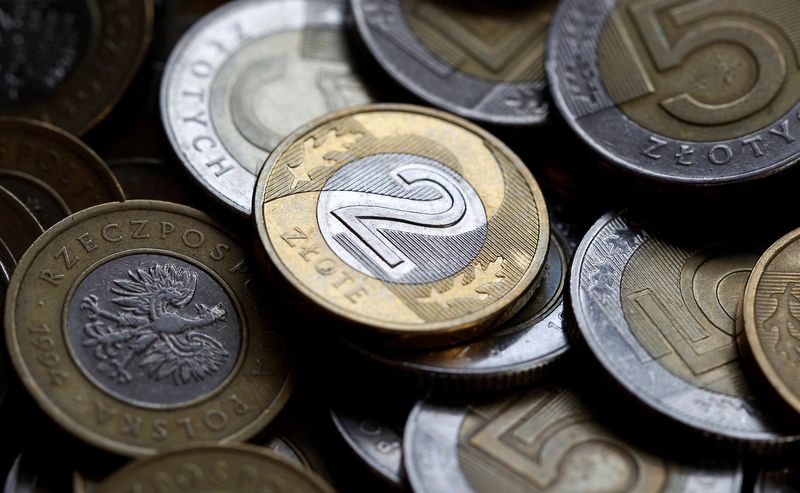Forex
CEE FX set to weaken as rate cuts come into view: Reuters poll


© Reuters. FILE PHOTO: Polish currency zloty coins are seen in this photo illustration taken in Warsaw, Poland, September 29, 2012. REUTERS/Peter Andrews/File Photo
By Jason Hovet and Alan Charlish
WARSAW/PRAGUE (Reuters) – Central European currencies are expected to weaken over the next 12 months with the taking the biggest hit, a Reuters poll showed, as higher inflation compared to the euro zone and the prospect of interest rate cuts weigh.
The region’s currencies have made a strong start to the year, supported by high interest rates and easing energy prices that have taken pressure off trade balances.
But with Hungary’s central bank having already started to loosen policy and more rate cuts predicted in the region this year, analysts expect currencies to fall.
In Poland, where markets think the cost of credit will fall in the fourth quarter, the zloty is expected to weaken 2.7% compared to Tuesday’s European close to 4.55 versus the euro.
“I think the market could be underestimating the length of the economic slowdown the CEE economies will suffer and we will probably have some talk about interest rate cuts, so amid high inflation this will weigh on the CEE currencies,” Ipopema Securities economist Marcin Sulewski said.
The National Bank of Hungary (NBH) has already cut its key one-day deposit rate by a total of 200 basis points to 16% to ease the burden on the stagnating economy. Inflation, which remains the highest in the European Union, has started to ease.
“HUF has the potential to weaken if we see stronger-than-expected disinflation, possibly resulting in increased bets on more aggressive NBH easing,” said ING economist Peter Virovacz.
The is expected to fall 1.3% to 380.0 against the euro, according to the poll. The , tightly controlled by the central bank, is seen falling 1.0% to 5.0 versus the euro
“In Romania, the new government decided to deploy a new tool to limit still substantial prices pressures related to expensive food,” Generali Investments analyst Jakub Kratky said.
“Although consumer prices in Romania are largely sensitive to the exchange rate, it could soon allow the central bank to let leu depreciate slightly.”
The is forecast to weaken the least of the region’s currencies, falling 0.1% to 23.775.
(For other stories from the July Reuters foreign exchange poll:)

 Forex3 years ago
Forex3 years agoForex Today: the dollar is gaining strength amid gloomy sentiment at the start of the Fed’s week

 Forex3 years ago
Forex3 years agoUnbiased review of Pocket Option broker

 Forex3 years ago
Forex3 years agoDollar to pound sterling exchange rate today: Pound plummeted to its lowest since 1985

 Forex3 years ago
Forex3 years agoHow is the Australian dollar doing today?

 Cryptocurrency3 years ago
Cryptocurrency3 years agoWhat happened in the crypto market – current events today

 World3 years ago
World3 years agoWhy are modern video games an art form?

 Commodities3 years ago
Commodities3 years agoCopper continues to fall in price on expectations of lower demand in China

 Economy3 years ago
Economy3 years agoCrude oil tankers double in price due to EU anti-Russian sanctions





















